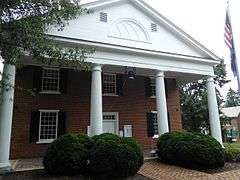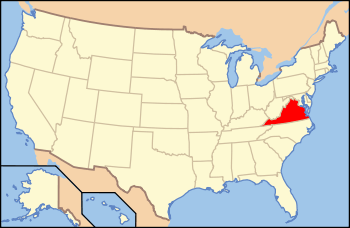Charlotte County, Virginia
| Charlotte County, Virginia | |
|---|---|
 Charlotte County Courthouse in September 2014 | |
 Location in the U.S. state of Virginia | |
 Virginia's location in the U.S. | |
| Founded | 1764 |
| Named for | Queen Charlotte |
| Seat | Charlotte Court House |
| Largest town | Keysville |
| Area | |
| • Total | 478 sq mi (1,238 km2) |
| • Land | 475 sq mi (1,230 km2) |
| • Water | 2.2 sq mi (6 km2), 0.5% |
| Population (est.) | |
| • (2015) | 12,201 |
| • Density | 26/sq mi (10/km²) |
| Congressional district | 5th |
| Time zone | Eastern: UTC-5/-4 |
| Website |
www |
Charlotte County is a United States county located in the south central part of the Commonwealth of Virginia. Its county seat is the town of Charlotte Court House.[1] As of the 2010 census, the county population was 12,586.[2] Charlotte County is predominately rural with a population density of only 26.5 persons per square mile.
The county was formed in 1764 from Lunenburg County, and it is named for Queen Charlotte, wife of King George III of England. The county residents later became staunch supporters of independence and the American Revolution, and Founding Father Patrick Henry was one of its most famous residents. His grave and the national memorial dedicated to him is located in Charlotte County.
History

European settlement of the future county began in the early 18th century,[3] and early settlers included mostly English people, with some French Hugenots and Scotch-Irish.[4] After approximately fifty years of European settlement, the House of Burgesses established and incorporated Charlotte County in 1764 from part of Lunenburg County. The new county was named in honor of Charlotte of Mecklenburg-Strelitz, the Queen and wife of King George III of England.[5]
Residents of Charlotte County were heavily involved in the American Revolution. County delegates supported resolutions against the Stamp Act of 1765,[4] and the county government was the second governing body to declare independence from English rule.[3] In addition, Charlotte militia units fought under General Robert Lawson during the Yorktown campaign, which effectively lead to the end of the American War of Independence.[4] Finally, the final resting place and national memorial to revolutionary hero Patrick Henry is at Red Hill Plantation.[6]
Charlotte County has also played a role in other wars on American soil. An artillery company from Charlotte played a key role in the Battle of Craney Island during the War of 1812.[4] Also, a significant battle in the American Civil War occurred in Charlotte and Halifax counties during the Battle of Staunton River Bridge, which resulted in a victory for the Confederacy.[3]
Geography
According to the U.S. Census Bureau, the county has a total area of 478 square miles (1,240 km2), of which 475 square miles (1,230 km2) is land and 2.2 square miles (5.7 km2) (0.5%) is water.[7] The county is bounded on the southwest by the Roanoke River, locally known as the "Staunton River". The terrain is hilly.[8]
Adjacent counties
- Prince Edward County – north
- Lunenburg County – east
- Mecklenburg County – southeast
- Halifax County – southwest
- Campbell County – west
- Appomattox County – northwest
Major highways
Demographics
| Historical population | |||
|---|---|---|---|
| Census | Pop. | %± | |
| 1790 | 10,078 | — | |
| 1800 | 11,912 | 18.2% | |
| 1810 | 13,161 | 10.5% | |
| 1820 | 13,290 | 1.0% | |
| 1830 | 15,252 | 14.8% | |
| 1840 | 14,595 | −4.3% | |
| 1850 | 13,955 | −4.4% | |
| 1860 | 14,471 | 3.7% | |
| 1870 | 14,513 | 0.3% | |
| 1880 | 16,653 | 14.7% | |
| 1890 | 15,077 | −9.5% | |
| 1900 | 15,343 | 1.8% | |
| 1910 | 15,785 | 2.9% | |
| 1920 | 17,540 | 11.1% | |
| 1930 | 16,061 | −8.4% | |
| 1940 | 15,861 | −1.2% | |
| 1950 | 14,057 | −11.4% | |
| 1960 | 13,368 | −4.9% | |
| 1970 | 11,551 | −13.6% | |
| 1980 | 12,266 | 6.2% | |
| 1990 | 11,688 | −4.7% | |
| 2000 | 12,472 | 6.7% | |
| 2010 | 12,586 | 0.9% | |
| Est. 2015 | 12,201 | [9] | −3.1% |
| U.S. Decennial Census[10] 1790–1960[11] 1900–1990[12] 1990–2000[13] 2010–2013[2] | |||
As of the census[14] of 2000, there were 12,472 people, 4,951 households, and 3,435 families residing in the county. The population density was 26 people per square mile (10/km²). There were 5,734 housing units at an average density of 12 per square mile (5/km²). The racial makeup of the county was 65.51% White, 32.89% Black or African American, 0.14% Native American, 0.16% Asian, 0.70% from other races, and 0.59% from two or more races. 1.65% of the population were Hispanic or Latino of any race.
There were 4,951 households out of which 28.10% had children under the age of 18 living with them, 52.50% were married couples living together, 13.00% had a female householder with no husband present, and 30.60% were non-families. 27.40% of all households were made up of individuals and 13.30% had someone living alone who was 65 years of age or older. The average household size was 2.47 and the average family size was 3.00.
In the county, the age distribution of the population shows 24.30% under the age of 18, 7.20% from 18 to 24, 26.20% from 25 to 44, 24.80% from 45 to 64, and 17.50% who were 65 years of age or older. The median age was 40 years. For every 100 females there were 92.00 males. For every 100 females age 18 and over, there were 90.70 males.
The median income for a household in the county was $28,929, and the median income for a family was $34,830. Males had a median income of $26,918 versus $20,307 for females. The per capita income for the county was $14,717. About 12.70% of families and 18.10% of the population were below the poverty line, including 22.10% of those under age 18 and 20.80% of those age 65 or over.
Elected officials
Board of Supervisors
- Royal S. Freeman (I), District G – Bacon/Saxe, Chairman — Term expires 12-31-19
- Gary D. Walker (R), District A – Charlotte Court House — Term expires 12-31-19
- Warren E. Weston (I), District B – Wylliesburg/Red Oak — Term expires 12-31-17
- Garland H. "Butch" Hamlett, Jr. (I), District C – Drakes Branch, Vice-Chairman — Term expires 12-31-19
- Robert L. "Butch" Shook, Jr. (I), District D – Keysville — Term expires 12-31-17
- Nancy R. Carwile (I), District E – Cullen/Red House, Vice-Chairman — Term expires 12-31-19
- Haywood J. Hamlett (I), District F – Aspen/Phenix — Term expires 12-31-17
The Board of Supervisors is the legislative policy making body for the County. It considers and adopts policies regarding administration, budget, finance, economic development, health, planning, public safety, childcare, recreation, sanitation and waste removal. The Board appropriates funds for all functions, including the schools, Social Services, Law Enforcement and operation of courts. The Board's regularly scheduled meetings are held on the second Tuesday of each month at 1:30 pm in the Board of Supervisors Room of the County Administration Building, 250 LeGrande Avenue, Suite A, (PO Box 608) Charlotte Court House, Virginia, 23923.
Sheriff
Thomas Jones (I) is the sheriff. The Sheriff is responsible for overseeing criminal investigations, calls for service, court room security, service of civil process and the operation of the Charlotte County jail.
Clerk of Court
The clerk is Nan R. Colley(I). The Charlotte County Clerk of the Circuit Court manages the records for the Judicial Circuit. In addition, Colley manages the records for the Judicial Circuit and serves as general record keeper for the County, recording all documents relating to land transfers, deeds, mortgages, wills, divorces and other statistics that date back to 1765.[15]
Commissioner of the Revenue
Naisha P. Carter (I) is the Commissioner of the Revenue.
Commonwealth's Attorney
William E. Green, Jr. (I) is the Commonwealth's Attorney, a position similar to that of District's Attorney in many other states.
Treasurer
Patricia P. Berkeley (I) is the Treasurer.
County Administrator
Charlotte County's administrator is Russell B. Clark. Clark's duties include and are not limited to: general administration, personnel management and supervision of all county departments, budget preparation, funds management, purchasing, property management, compliance with laws, regulations and ordinances, coordination with independent agencies and the community, representing the Board at meetings and functions, and any and all other duties imposed by the Board and by law to facilitate the accomplishment of the work of county government.
Members of the School Board
- Larry Fannon, District A (Charlotte Court House)
- William "Bill" Devin, District B (Wylliesburg/Red Oak)
- Gloria Talbott, District C (Drakes Branch)
- R.B. "Jay" George, District D (Keysville)
- Henry Carwile, District E (Cullen/Red House)
- Kenny Redmond, District F (Phenix/Aspen)
- JonPaul Berkley, District B (Bacon/Saxe)
- Dana Ramsey, Clerk of the Board
Voter Registrar
Nan Lambert
Communities
Towns
Unincorporated
Notable residents
- David K. E. Bruce – diplomat and politician
- Isaac Dabbs – politician
- Patrick Henry – politician and Founding Father
- William Hoffman- famous author
- John McCargo- NFL player for the Buffalo Bills
- John Randolph – politician
See also
References
- ↑ "Find a County". National Association of Counties. Archived from the original on 2011-05-31. Retrieved 2011-06-07.
- 1 2 "State & County QuickFacts". United States Census Bureau. Retrieved January 1, 2014.
- 1 2 3 "Charlotte County: History". Charlotte County. Retrieved 12 May 2015.
- 1 2 3 4 Bailey, Annie Lou D. "History of Charlotte County; Sketch No.1". The Charlotte Gazette, Drakes Branch (April 30, 1964). Retrieved 12 May 2015.
- ↑ Salmon, edited by Emily J.; Jr, Edward D.C. Campbell, (1994). The Hornbook of Virginia History : a ready-reference guide to the Old Dominion's people, places, and past (4th ed.). Richmond: Library of Virginia. ISBN 0884901777.
- ↑ "Biography of Patrick Henry". Red Hill Patrick Henry National Memorial. Retrieved 13 May 2015.
- ↑ "US Gazetteer files: 2010, 2000, and 1990". United States Census Bureau. 2011-02-12. Retrieved 2011-04-23.
- ↑
 Ripley, George; Dana, Charles A., eds. (1879). "Charlotte, a S. county of Virginia". The American Cyclopædia.
Ripley, George; Dana, Charles A., eds. (1879). "Charlotte, a S. county of Virginia". The American Cyclopædia.
- ↑ "County Totals Dataset: Population, Population Change and Estimated Components of Population Change: April 1, 2010 to July 1, 2015". Retrieved July 2, 2016.
- ↑ "U.S. Decennial Census". United States Census Bureau. Archived from the original on May 11, 2015. Retrieved January 1, 2014.
- ↑ "Historical Census Browser". University of Virginia Library. Retrieved January 1, 2014.
- ↑ "Population of Counties by Decennial Census: 1900 to 1990". United States Census Bureau. Retrieved January 1, 2014.
- ↑ "Census 2000 PHC-T-4. Ranking Tables for Counties: 1990 and 2000" (PDF). United States Census Bureau. Retrieved January 1, 2014.
- ↑ "American FactFinder". United States Census Bureau. Archived from the original on 2013-09-11. Retrieved 2011-05-14.
- ↑ http://www.charlotteva.com/cc_clerk.htm
External links
 |
Appomattox County | Prince Edward County |  | |
| Campbell County | |
Lunenburg County | ||
| ||||
| | ||||
| Halifax County | Mecklenburg County |
Coordinates: 37°01′N 78°40′W / 37.01°N 78.66°W